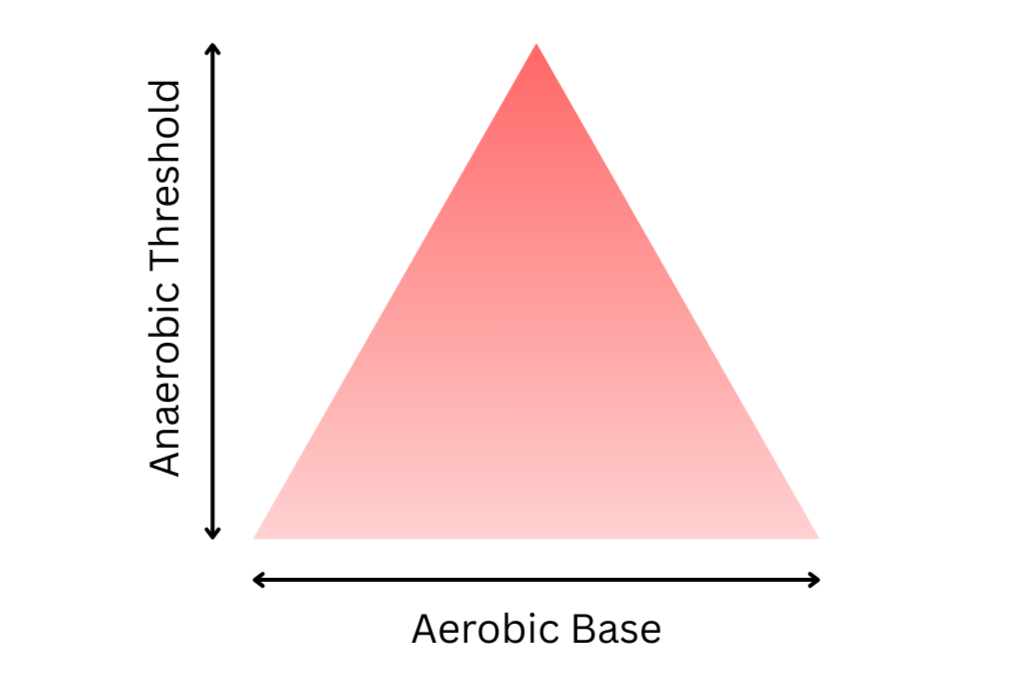Conditioning
Good conditioning, also known as metabolic conditioning, measures your body's ability to create energy efficiently. Improving your metabolic conditioning delivers profound health benefits that go far beyond athletic performance:
9-11% reduction in all-cause mortality for each unit increase in VO2 max¹
Each additional 1 ml/kg/min of VO2 max associated with 9% reduction in mortality risk²
Significant decreases in inflammatory markers
Improved blood glucose control and insulin sensitivity³
Better HDL cholesterol and lower triglycerides
Enhanced cardiovascular health markers
At a high level, your body's energy currency is a molecule called ATP (adenosine triphosphate)—an adenosine molecule surrounded by three phosphate molecules. Every time your body needs energy, like contracting a muscle, one phosphate molecule breaks away from the adenosine. This process continues until all phosphate molecules are gone, and your body must regenerate ATP to keep functioning.
Your body regenerates ATP through three metabolic pathways, each optimized for different demands:
Phosphocreatine pathway - for explosive, high-intensity efforts lasting up to 30 seconds (like an all-out 100m sprint)
Glycolytic pathway - for medium-intensity efforts lasting 1-3 minutes (like a 1500m run)
Oxidative pathway - for sustained, lower-intensity efforts that can continue indefinitely (like a marathon)
All of these energy production processes happen in your mitochondria—organelles found in most cells. This is why keeping mitochondria healthy and plentiful is crucial for performance and longevity. Metabolic conditioning is about making mitochondria function properly, while hot and cold exposure helps make them more plentiful.
The Conditioning Triangle
A visual analogy that I've found helpful for understanding conditioning is the following triangle:
The width of the base represents your aerobic base—your cardiovascular system's ability to efficiently use oxygen for sustained, low-to-moderate intensity exercise. This foundation determines your endurance capacity and how efficiently you can burn fat for fuel. The height of the triangle represents your anaerobic threshold—the highest exercise intensity at which your body can clear lactate as fast as it's produced.⁴ In untrained individuals, this threshold typically occurs at around 50-60% of VO2 max, while trained athletes can push this to 70-80% of their VO2 max.⁵
Improving your conditioning means growing the total area of this triangle, and you can do that by widening the base and increasing the height.
Widening the base (improving your aerobic capacity) means enhancing your body's ability to efficiently use oxygen during sustained, low-to-moderate intensity exercise. You accomplish this through Zone 2 training—long, steady efforts where you can maintain a conversation with some difficulty, typically at 60-70% of your maximum heart rate.⁶
Increasing the height (raising your anaerobic threshold) requires improving your body's ability to produce and clear lactate efficiently. You achieve this through High Intensity Interval Training (HIIT), which research shows is significantly more effective than moderate-intensity work for improving VO2 max when matched for total work output.⁷
In short, the most effective approach to building superior conditioning is a balanced protocol of Zone 2 training combined with strategic high-intensity intervals.
My Training Protocol
For Zone 2 training, research shows that 150-300 minutes per week provides optimal benefits for most individuals, with 150 minutes being the minimum effective dose.⁸ For HIIT, the goal is 30 to 60 minutes per week, which maintains the 80/20 intensity distribution favored by elite endurance athletes—80% of training time in lower zones, 20% in high-intensity work.⁹
I accomplish this by adding a metabolic conditioning session after each of my resistance training sessions, plus choosing to walk at a brisk pace and take stairs over elevators whenever possible. I'm in the gym 4 to 6 times per week, and I structure my conditioning as follows:
Zone 2 Sessions (2x per week): 30-60 minutes at conversational pace where I can speak 3-5 words before needing a breath, but couldn't, for example, sing along to my music. These sessions primarily burn fat for fuel and build mitochondrial capacity.
Mixed Intensity Sessions (2-4x per week): The rest of my sessions are higher intensity, balanced between Zone 3 work (10-20 minutes at medium intensity) and targeting my anaerobic threshold with 2-4 minute intervals at very high intensity. However, I limit myself to no more than 2 sessions per week at the highest intensity, since my body won't recover properly if I exceed that frequency.
This approach ensures I'm building both the aerobic base and the anaerobic ceiling that create a robust conditioning foundation—one that supports not just athletic performance, but long-term health and longevity.
References
Mandsager, K., et al. (2018). Association of Cardiorespiratory Fitness With Long-term Mortality Among Adults Undergoing Exercise Treadmill Testing. JAMA Network Open, 1(6):e183605. Meta-analysis of 122,007 adults showing 11% reduction in mortality per metabolic equivalent increase.
Laukkanen, J.A., et al. (2016). Long-term Change in Cardiorespiratory Fitness and All-Cause Mortality: A Population-Based Follow-up Study. Mayo Clinic Proceedings, 91(9):1183-8. Each 1 ml/kg/min increase associated with 9% mortality risk reduction.
Levels Health Blog. The metabolic benefits of slow, steady Zone 2 exercise. Study showing 60-minute Zone 2 session increased insulin-dependent glucose disposal by 67-97%.
Davis, J.A., et al. Anaerobic threshold occurred at 59.8 ± 7.4% VO2 max for respiratory gas exchange method.
Ghosh, A.K. (2004). Anaerobic threshold: its concept and role in endurance sport. The Malaysian Journal of Medical Sciences, 11(1), 24–36. Threshold occurs at 50-60% VO2max in untrained, 70-80% in trained individuals.
MyProCoach Heart Rate Training Zones. Zone 2 defined as 73% to 80% of max HR for steady endurance training that boosts fat utilization efficiency.
Helgerud, J., et al. (2007). Aerobic high-intensity intervals improve VO2max more than moderate training. Medicine & Science in Sports & Exercise. High-intensity intervals significantly more effective than lactate threshold training.
Sports Medicine Weekly, Dr. Brian Cole. Exercise in Zone 2 for 150 minutes per week for optimal fat loss and metabolic benefits.
SiPhox Health. Research suggests 150-300 minutes per week of Zone 2 exercise provides optimal longevity benefits, with polarized training approach (80% low intensity, 20% high intensity).


